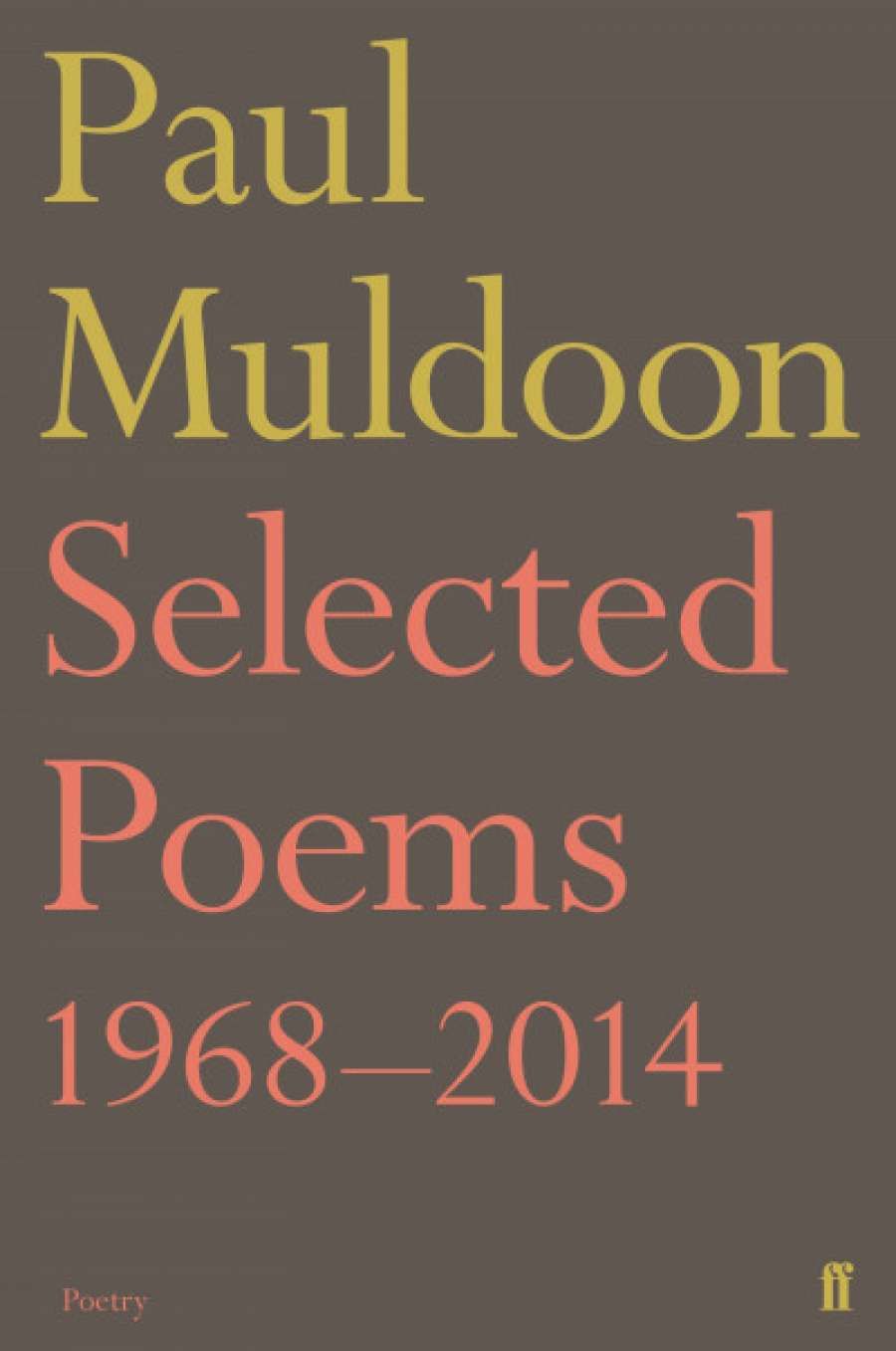
- Free Article: No
- Contents Category: Poetry
- Custom Article Title: Anthony Lawrence reviews 'Selected Poems 1968–2014' by Paul Muldoon
- Review Article: Yes
- Online Only: No
- Book 1 Title: Selected Poems 1968–2014
- Book 1 Biblio: Faber Poetry, $34.99 hb, 240 pp, 9780571327959
Selected Poems 1968–2014 is a radical departure from Poems 1968–1998, which contained the complete texts of every book between New Weather (1973) and Hay (1998). At almost five hundred pages, the earlier collection is a formidable body of work from a poet in his late forties. This new, honed-back selection finds Muldoon in minimalist form, offering only five poems from the twelve collections which take up where Hay left off, and ending with One Thousand Things Worth Knowing (2015).
Muldoon’s central themes, while being reduced in scope, are still given room to breathe and move here – landscape, family and community, animals, relationships, and language itself – represented by shorter, lyrical poems as well as a number of the longer narratives that traditionally bookend his collections. Muldoon has long been recognised as a master of rhyme and formality. His sonnets can remain true to the Italian or Elizabethan form, they can merge the rhyme schemes and stanzaic structures of both, or they can be composed in any way Muldoon feels is appropriate at the time. It is hard to argue with someone who knows that for experimentation to work there must first be an understanding and mastery of the technical aspects of the form being deconstructed. ‘The More a Man Has the More a Man Wants’ (The Annals of Chile, 1994) contains forty-nine stanzas, each one a sonnet. ‘Incantata’, based on Yeats’s elegy for Major Robert Gregory, employs the same end-rhymes that Muldoon used in the long poem ‘Yarrow’ (also from The Annals of Chile, but not included here) in reverse order.
The poems containing animals are among Muldoon’s finest works. These creatures never make random appearances, and are often seen in terms of local history and cultural significance. His books are filled with horses, pigs, badgers, armadillos, beavers, frogs, fish, birds, rabbits, foxes, and panthers. While his concerns are largely anthropomorphic, he also celebrates an animal’s natural form and habitat. From the earliest Robert Frost-inspired poems from New Weather (1973) like ‘Dancers at the Moy’, in which horses abandoned at a sale are left to starve to death, and ‘Hedgehog’; to the more autobiographical, Louis MacNeice-influenced poems that range, often parabolically across subsequent volumes, Muldoon’s visionary, transforming approach ensures that no pastoral or portrayal of animal will ever rely on linear description.
Some critics have called attention to Muldoon’s use of cliché. He has made them part of the fabric of many poems, yet he does so playfully, mischievously, as a way to compare and contrast ideas while tipping his hat to MacNeice, whose poem ‘Homage to Clichés’ would almost certainly have been an influence on the younger poet: ‘You can lead a horse to water but you can’t make it hold / its nose to the grindstone and hunt with the hounds. / Every dog has a stitch in time. Two heads? You’ve been sold / one good turn. One good turn deserves a bird in the hand.’ (‘Symposium’, from Hay)
 Paul Muldoon
Paul Muldoon
(photograph by the Newcastle Centre for the Literary Arts, via Flickr)Some readers may sense, having read through these linguistically complex poems, that Muldoon has passed over genuine feeling to achieve technical brilliance. His ornate, intricate explorations of the sonnet, sestina, and extended narratives tend to focus our attention on his mastery of balancing vowel and consonant to achieve music that best suits his subject matter. And yet, despite his deliberate attempts to disrupt and unsettle syntax, there is an undercurrent of intense order and crafted design that attends to even the strangest, most disorienting poems. ‘Incantata’ is a fine example. An elegy to his friend and ex-partner, the printmaker Mary Farl Powers, it is Muldoon’s most ambitious poem, and repeated readings unearth linguistic delights rarely seen in the work of his contemporaries. There are riddles and nods to Samuel Beckett (Sam Bethicket), references to the massacre at Culloden prior to the Scottish ‘Clearances’ and to the slaughter of Mexicans at Chickamauga. The violence is both historical and intensely personal as it backgrounds Muldoon’s lament for the terminally ill Powers.
In these twisting, elusive, yet strangely intimate poems, Muldoon is asking us to investigate Robert Frost’s ‘straight crookedness’, where the poet should trust in the unknown for the poem to arrive at its own destination, in the form it takes on, along the way. Even with the sonnet and sestina, Frost’s philosophy has been taken seriously. In the hands of a poet like Muldoon, the borders of a particular form offer no constraints.
Paul Muldoon is conspiratorial, incantatory, subversive, self-conscious, and extravagant. He is a poet for whom the word ‘etymology’ seems perfectly suited, as he loves nothing more than to follow the paper or electronic trail to where a word hits a wall, or breaks into other parts worth tracking down.


Comments powered by CComment